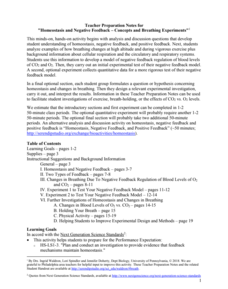Serendip
Homeostasis, Negative Feedback, and Positive Feedback
So many bodily activities depend on homeostasis! Give learners a solid background to understand the basic process of the human body. Scholars first examine negative feedback loops contributing to body temperature regulation and then a...
EngageNY
End of Unit Assessment, Part 1, Continued: Revising Vocabulary and Conventions Based on Feedback
Writers align their position papers with the last two rows in the rubric. After looking at the rubric rows for vocabulary and conventions along with feedback on their papers, class members revise their essays. They then look at the...
Serendip
Homeostasis and Negative Feedback – Concepts and Breathing Experiments
More asthma attacks happen at higher altitudes, but why? Scholars complete worksheets, learning about homeostasis and feedback related to breathing. Then, they work in small groups to experiment with breathing in limited amounts of...
Curated OER
Homeostasis and Feedback Worksheet
In this homeostasis activity, students sketch and label graphs showing homeostasis for the following conditions: blood glucose, temperature, systolic blood pressure, and blood pH. Students define and give an example of positive feedback....
Polar Trec
Permafrost Thaw Depth and Ground Cover
The thaw depth of tundra creates a positive feedback loop with both global warming and the carbon cycle. Scholars sort photos and develop a hypothesis for ground cover and permafrost depth. Then they review the data and measurements...
Curated OER
Homeostasis
In this homeostasis worksheet, learners answer twelve questions about positive and negative feedback loops and how they effect homeostasis.
It's About Time
How Might Global Warming Affect Your Community?
What effects will global warming have on your community? This last installment of a six-part series focuses on the effects that global warming may have on a community. Brainstorming and discussion allow groups to independently develop...
Curated OER
Reflecting on Reflectivity
Students plan and construct a "mini-lab" to measure the reflectivity of different earth surfaces. They measure reflectivity of materials, including ice, soil, rocks, etc., and then extrapolate from what they have learned to consider the...
Curated OER
Latch Circuits
In this circuit activity learners complete a series of short answer questions using circuit diagrams to show the input and output of different switches.
Curated OER
Sea State
Students explain the process of wave formation and analyze the relationship between the ocean and the atmosphere. In this oceans lesson students use buoys to cast real time sea state conditions.
Curated OER
Climate Change: Carbon Cycle
Learners explore the carbon cycle. In this carbon cycle lesson, students discuss the four main reservoirs where carbon is stored and then discover the process through which each reservoir absorbs and releases CO2. This lesson includes a...
Curated OER
A Model of a Scanning Tunneling Microscope
Ninth graders explain how a scanning tunneling microscope works. In this chemistry lesson, 9th graders construct atomic models and simulate how their images appear under the STM. They discuss the limitations of their atomic model.
Curated OER
Stepper Motor
Students compare a stepper motor from a traditional motor. For this physics lesson, students summarize how it works. They build their own stepper motor and explore its uses.
Curated OER
Losing An Island
Students examine carbon dioxide and determine the impact of greenhouse gases on the earths spheres. In this pollution lesson students complete a lab activity to see the impact of gases on the environment,
TED Talks
Ted: Ted Ed: Feedback Loops: How Nature Gets Its Rhythms
Anje-Margriet Neutel describes some common positive and negative feedback loops, examining how an ecosystem's many loops come together to make its 'trademark sound.' [5:11]
CK-12 Foundation
Ck 12: Hormone Regulation
[Free Registration/Login may be required to access all resource tools.] In the following online tutorial students will learn to describe feedback mechanisms that regulate hormone secretion.
OpenStax
Open Stax: Homeostasis
This section of a textbook provides information regarding human homeostasis, a process that has the body continuously monitor its internal conditions. Includes a linked video.
CK-12 Foundation
Ck 12: Biology: Hormone Regulation
[Free Registration/Login may be required to access all resource tools.] Describes how feedback mechanisms regulate hormone secretion.




















